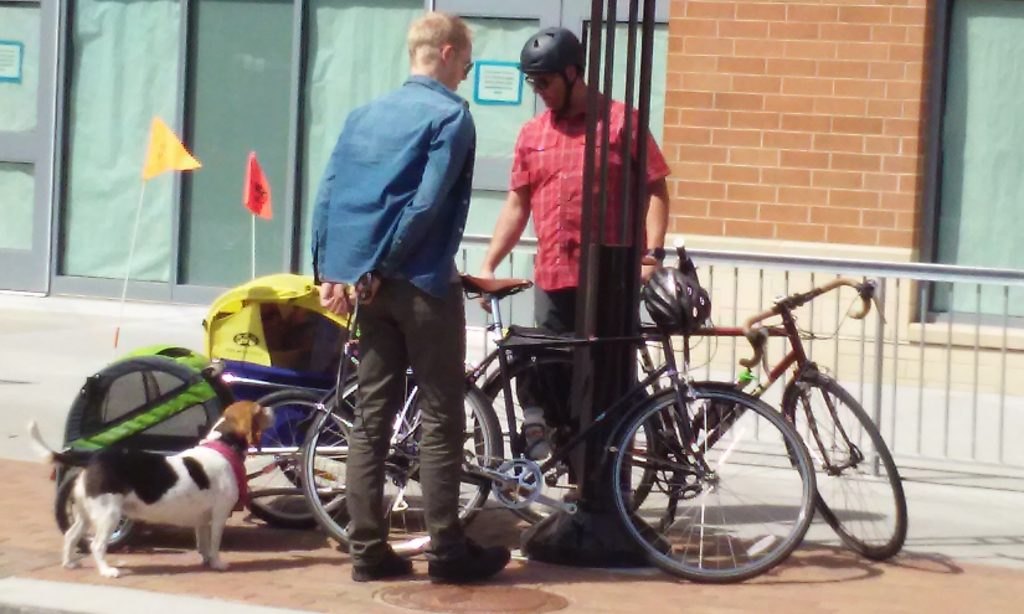It’s that time again. Time for students to get their supplies together for the start of school, and for the teachers to do the same. Does the list include a bike, lock and helmet? In 1969 40% of kids walked or rode bikes to school. Today 11%. The reasons for this change vary, but one of them is a perceived lack of safety. I’ve had parents tell me they wouldn’t let their child ride to school because they know of a child who was hit in a crosswalk on their bike. Fair enough. What can be done to reverse this trend? Unfortunately, many consider the safety solution to lie in more parking areas for people to drop off students ever closer to their schools. I don’t believe the answer is to be found in just not riding or walking to school. It’s to be found in addressing the problems that keep kids from riding to school, and I believe that they are the same problems that keep many adults from riding to work. Safer streets. Creating a bike bus is one way, but I’ve talked about that before.
Lincoln has two safer streets initiatives. The first, under the Metropolitan Planning Organization, is known as Complete Streets. Complete Streets is a multi-modal active transportation plan. From the city website:
“The Fiscal Year 2014/15 Capital Improvement Program (CIP) included, for the first time, a budget item for the Pedestrian and Bicycle Capital Program. In each year since, $50,000 has been appropriated for projects that work towards creating a “complete street” network. This includes improvements that support pedestrian, bicycle, transit, and vehicular safety such as new ADA compliant sidewalk connections, bicycle route signage and bike rack installation, data transfer for the trail counters, and safety installations at street crossings… Complete Streets are public and private streets that include some combination of appropriate infrastructure, as determined by the surrounding context, that accommodate all modes of transportation, including private vehicles, public transportation, walking, and bicycling. For more detailed information on Complete Streets, please visit the National Complete Streets Coalition. “

I won’t claim that this program alone will assuage your fears of commuting, but it’s a start.
The second way the city proposes to make it safer to ride is through LTU’s Safe Streets Lincoln initiative. The initiative is part of Vision Zero’s National, and International, goal to eliminate roadway fatalities and reduce suspected serious injuries. LTU has set a goal of a 60% reduction in these by 2045. Traffic fatalities and injuries are considered a public health issue.
From the City’s Safe Streets Lincoln page: “For example, the implementation of high-visibility crosswalks is a proven safety countermeasure effective in reducing pedestrian injury crashes by up to 40%, according to the Federal Highway Administration (FHWA). The implementation of high-visibility crosswalks is already a tool in our arsenal that we will continue to leverage in roadway projects.” I have to add here that it’s not enough to present the motorist with visible crosswalks. They have to be willing to stop, which is something I haven’t seen a lot of evidence for. To be sure, many do stop, but they may be in the minority.
Here’s more about Vision Zero, and a couple of examples where it has been successful. It’s apparently more successful in Europe than in the U.S., with a couple of exceptions. Here are a few excerpts:
Vision Zero is a strategy to eliminate all traffic fatalities and severe injuries, while increasing safe, healthy, equitable mobility for all. First implemented in Sweden in the 1990s, Vision Zero has proved successful across Europe — and now it’s gaining momentum in major American cities.
The Problem
Each year, more than 42,000 people — the population of a small city — are needlessly killed on American streets and thousands more are injured. We call this suffering traffic “accidents” — but, in reality, we have the power to prevent traffic collisions.
For too long, we’ve considered traffic deaths and severe injuries to be inevitable side effects of modern life. While often referred to as “accidents,” the reality is that we can prevent these tragedies by taking a proactive, preventative approach that prioritizes traffic safety as a public health issue.
The significant loss of life exacts a tragic toll, extending beyond personal loss to deep community impacts, including: personal economic costs and emotional trauma to those suffering; and significant taxpayer spending on emergency response and long-term healthcare costs. And because so many fear for their safety on our streets, there is no true freedom of mobility, and, as a result, we compromise our public health with increasing rates of sedentary diseases and higher carbon emissions.
A New Vision for Safety

“So cities that adopt Vision Zero policies are battling not only national headwinds like larger and more dangerous passenger vehicles and cultural issues related to the pandemic that have contributed to reckless driving. They also are trying to create an entirely new framework for addressing a problem oftentimes against the systems in place at the more powerful and better resourced agencies handing down programs and policies.
Other success stories are starting to emerge. Hoboken, a small, densely populated city of 60,000 just outside NYC’s borders, has achieved dramatic improvements in pedestrian safety thanks to a potentially widely replicable formula that has relied a lot on inexpensive intersection designs, particularly a practice called “daylighting” that improves visibility. Hoboken hasn’t had a traffic death in four years.”
Nearby Jersey City has not had a single traffic fatality so far this year on non-state roads, and only five deaths on state roads. Advocacy group Safe Streets JC credits the city’s progress with aggressive action on road diets, bike lanes and smaller scale interventions like curb bump-outs. By comparison, similarly sized Cincinnati has had 30 deaths so far this year.”
https://www.bloomberg.com/news/articles/2022-11-25/the-us-cities-where-vision-zero-traffic-safety-fixes-are-working
https://www.bloomberg.com/news/features/2022-12-28/it-s-been-a-deadly-year-on-us-roads-except-in-this-city
